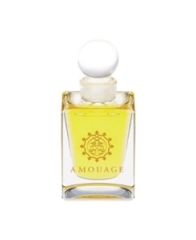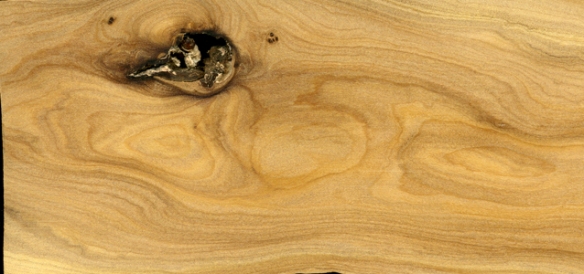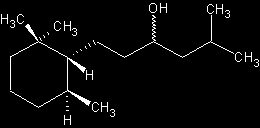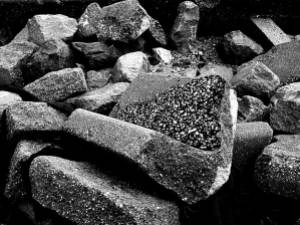
Source: standout-fireplace-designs.com
A man in a library before a crackling fire, sipping cognac on a leather sofa, as the air around him swirls with a phantasmagoric stream of colours. Burnt umber, raw ocher, dusty terracotta, dark tobacco, golden caramel, nutty toffee, and a touch of blackened green. There are hints of spice and smoke in the air, along with a musky earthiness, but it is a scene of endless warmth, coziness, and richness.
Then, as if a magician waved his hand, the swirling coloured mists dissolve, and the scene changes. The man has been transported outdoors to a land filled with dark, mentholated greens, touched by earthy browns, and a hint of reddened dust. It’s muddy at times, and a muted chanting sound in the background momentarily conjures up the Summer of Love in 1968. It’s only a brief trip, though, and soon, he finds himself in his bed, surrounded by the finest, gauzy, silky sheets made of soft red, ambered caramel gold, and creamy vanilla. Did it actually happen, or was it a trip most Psychédélique?

Source: Bloom Perfumery.
Psychédélique is a fragrance from Jovoy Paris, an utterly glorious patchouli scent in all its best, truest, spicy-sweet-smoky red-brown incarnations. The fragrance (which I shall spell here on out without the warranted accents, for ease and speed) is really close to my ideal patchouli, though it doesn’t have the best projection after its opening stage. But what an opening it is!
Psychedelique is an eau de parfum, created by Jacques Flori of Robertet and released in 2011. Jovoy’s owner and creative director, Francois Hénin, describes the scent and its notes as follows:
“Psychedelic: my great patchouli fragrance, dark and smoky, ambered, generous and opulent… Even the rain and mud of Woodstock won’t wash it away.”
Head notes: fresh hesperidium [citrus]
Heart notes: floral rose, geranium, ambered, woody (patchouli, cistus, gum cistus)
Base notes: vanilla, musk

Psychedelique with its box. Source: Roullier White.
Luckyscent has rather a wonderful description of Psychedelique:
Psychédélique, Jovoy’s magnificent ambered patchouli, largely stays in the shadows, meditating on the synergies between a cocoa-like amber and an inky-dark patchouli, although rose and geranium offer a touch of freshness to its earthy sexiness.
The synaesthete might say that on the olfactory color wheel, patchouli resides somewhere between black and chocolate brown, with a bit of iridescent chartreuse green shimmering in between. Camphory, inky, aromatic, and even darkly refreshing, the elegant patchouli in Psychédélique […] is like an olfactory Mark Rothko painting that explores the gradations between dark colors — in this case, patchouli, amber, and musk.

St. James Hotel’s Library Bar, Paris.
Source: Oyster.com
Luckyscent finds the name unfortunate, as do I, because it tends to create the impression that Psychedelique is a dirty, filthy, head-shop, incense-y fragrance best suited to hippies. It’s not. It’s extremely refined, elegant and well-done. For me, the image which came to mind again and again was primarily that of a traditional men’s club or a rich library, filled with dark, studded, stuffed Chesterfield leather sofas, a crackling fire, aged cognac, a hint of smoke in the air, and a plate of caramels. Yes, there is a mentholated, camphorous stage redolent of green patchouli, but it’s not significant on my skin, and really far from the core essence of the fragrance. In fact, most of the time, the green undertone translates as wonderful peppermint.

Source: porjati.ru
Psychedelique opens on my skin with strong labdanum amber and patchouli, infused by a huge amount of boozy cognac. The patchouli has all its true nuances: leathery, spicy, smoky, sweet, dry, woody, and with a hint of something almost resembling tobacco. Psychedelique even carries the faintest whiff of a fruited element that smells like cinnamon-studded oranges. A definite blast of chilly peppermint follows, arm in arm with chewy, dark chocolate. Patchouli’s camphorous, green side lurks underneath, along with a tinge of black, almost “head-shop” like incense, but they’re only the subtlest of suggestions on my skin. Much more significant is the utterly glorious toffee and caramel amber, just lightly flecked by creamy vanilla.
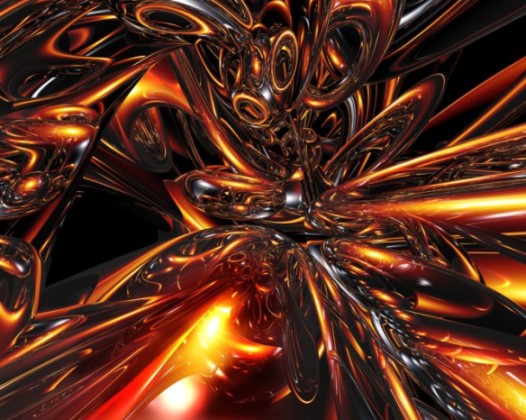
“Black Widow v1” by *smokin-nucleus. Source: DeviantArt. (Website link embedded within photo.)
It’s a very potent brew in the opening hour, especially when sniffed up close, but Psychedelique has a soft quality about it. It feels a lot denser and more concentrated than it actually is, and is only truly intense within its small 3 inch bubble. To me, the opening has the best aspects of Oriza L. Legrand‘s Horizon and of Reminiscence‘s Elixir de Patchouli, but with none of the latter’s swampy, smoked cedar and sharp vetiver. When smelled from afar, Psychedelique is a beautiful swirl of ambered caramel gold and reddened, spicy patchouli, infused with cognac, toffee, peppermint, dry cocoa, sweetness, and a hint of fruitiness.

Source: urlm.co
Within 5 minutes, Psychedelique starts to morph. At first, there is a dusty, dry earthiness that smells like damp, wet soil. To my regret, it cuts through some of the aged, boozy cognac which I love so much. At the same time, the rich amber in which all the notes are nestled turns slightly musky. There is also an increasing whiff of the salty-sweet aspect of the ambergris, mixed with the labdanum’s nutty, toffee’d caramel aroma. Chocolate and peppermint continue to be laced throughout, and there is the faintest stirrings of vanilla in the base, but there is nary a hint of a citrus, rose or geranium note in Psychedelique, regardless of what the ingredient list may say.

“Green and Maroon,” by Mark Rothko. Source: ArtTribune.com
It takes 25 minutes for Psychedelique’s greener side to become apparent. The fragrance becomes much more mentholated and camphorous; at the same time, the amber’s lovely caramel, vanilla, and toffee tonalities weaken. The boozy cognac retreats almost completely to the sidelines, and eventually vanishes before the hour is over. Psychedelique feels simultaneously softer, sharper, and dirtier. The dusty cocoa powder and chewy chocolate remain, but both are significantly more muted. Psychedelique is now very green-black in visual huge, instead of the red-brown-golds of the opening.

Source: rgbstock.com
I should point out, however, that the degree of greenness in this stage varied depending on the amount of perfume that I applied, and that the note was not a huge part of the scent in a few of my tests. The more Psychedelique you spray, the more the green phase seems to come out around the 30 minute mark. A number of times, the main duo of golden caramel and patchouli remained as the dominant focus alongside with the mentholated, green-black note. In other words, if you don’t spray on a lot of Psychedelique, the greenness doesn’t take over the scent.
In all cases, however, the stage is pretty short-lived, and lasts under an hour or so. Generally, it begins to recede 90 minutes into Psychedelique’s development. At that point, the fragrance begins its slow transformation back to its original stage, minus that wonderful cognac booziness and heavy richness. At the end of the second hour, Psychedelique is a soft, smooth blend of patchouli with amber and sweetness, and only vestigial traces of the greenness lurking to the side. The sillage is low, unfortunately, and Psychedelique hovers an inch above the skin.

Via hdwpapers.com
About 3.5 hours in, Psychedelique is a soft, spiced patchouli sweetened with creamy vanilla, and flecked by nutty, toffee’d labdanum. There are hints of cocoa powder, smokiness, and earthiness, but the whole thing is beautifully balanced. It’s neither too sweet, nor too spicy, smoky, chewy, or earthy. There is almost a dry woodiness to the plant, but Psychedelique never feels truly woody like some of its kin in the genre, many of whom are heavily infused with cedar and/or vetiver.
The whole thing is absolutely lovely, but it’s also a sheer, discrete skin scent — too much so for my personal preference. Unobtrusiveness seems to be the Jovoy style and signature, as all the other fragrances that I’ve tried from the line have been similar. They start with a bang that eventually fades to sheerness in a polite whimper. Here, I feel almost cheated. I’ve been looking for a great patchouli for ages, so to find one with a truly lovely opening and drydown, only to have to sniff my wrist with determination by the 4th hour is incredibly frustrating.
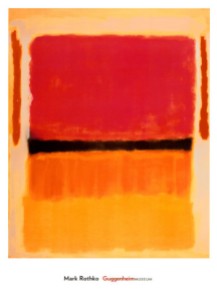
Mark Rothko, Untitled (Violet, Black, Orange, Yellow on White and Red), 1949. Source: The Guggenheim Museum.
On the plus side, however, Psychedelique lasts and lasts. It may take some determined whiffs to detect it at the end, but that end phase frequently lasts over 14 hours on my perfume-consuming skin. No, seriously, it does. The smallest quantity of Psychedelique will yield 12 hours at a minimum, with minuscule traces lasting up to the 14th hour. With a larger amount, the perfume’s longevity is well over-night. Just 3 small sprays from my tiny atomizer sample, amounting to 2 sprays from a regular bottle, made Psychedelique last 19.5 hours on me. I couldn’t believe it. Again, it did take some determined sniffing to detect, with my nose fully on the skin, but Psychedelique was definitely pulsating away in a few quarters on my arm.
In all cases, the drydown was a perfect, slightly spiced patchouli with vanilla and amber. Up until the 9th hour, the golden haze was flecked with a hint of chilly mentholated peppermint and a touch of cocoa powder. In its very final moments, Psychedelique was just a smear of golden sweetness.
On Fragrantica, Psychedelique has very positive reviews. A number of people compare the scent to Reminiscence’s take on the note, and one mentions Montale‘s Patchouli Leaves. On my skin, the Montale was very different and quite gourmand, while both Reminiscence fragrances were significantly woodier in nature. I think a much closer comparison would be to Oriza‘s Horizon, except the Psychedelique has greater heft, depth, and body. It’s also got better projection and longevity, as Horizon was painfully diaphanous on my skin. The Psychedelique feels much chewier as a whole, more ambered. It has more cocoa, and substantially more greenness than Horizon, too. If only it didn’t drop in projection after 2.5 hours!
In terms of helpful commentary, I think the reviews on Luckyscent are more useful than the Fragrantica ones in showing how Psychedelique may turn out on some skins. The two comments there read as follows:
- Psychedelique starts out on the sharp, dry end of the patchouli spectrum — not at all unpleasant, and rather similar to L’Artisan’s Patchouli Patch. But an hour later, the sharp notes have dropped back into place and the fragrance becomes warmer, more rounded and much more nuanced. There’s a really nice play between the drier and warmer elements of the fragrance. I totally agree that the name Psychedelique, and its connotations with dirty hippies and cheap patchouli, is rather unfortunate, because this is a sophisticated, very wearable patchouli-based scent.
- It’s funny, this one – I have almost a love/hate with it. If you’re patient and can wait for the drydown 30-60 minutes later, you’ll be thrilled. The [Luckyscent] description is as good one, but it takes awhile to get intoxicating. Initial blast is super sharp, but with time, your skin is left with a beautiful woodsy, ambered patchouli. My patience is good though and I bought a FB.
As a side note, a number of people in the blogosphere have been talking lately about Von Eusersdorff‘s Patchouli scent, and I got to try that while at Jovoy too. It was a brief, cursory test in the midst of a lot of other sniffing, so my perceptions may be a little skewed, but I thought Psychedelique was much better. It struck me as richer, deeper, chewier, darker, boozier, and significantly more intense. I remembering telling the manager at the time, “Ah, this is a proper patchouli.”
I’m seriously considering getting a full bottle of Psychedelique, but I keep hesitating. The perfume costs $180 for 100 ml, and the cheap-skate side of me is saying that $180 is quite a lot for what is essentially a patchouli-amber soliflore with sillage issues. At $180 with fantastic projection for the first 5-6 hours, I would have no problem whatsoever. At $140 with soft sillage, I probably would not hesitate, especially as 100 ml gives me the opportunity to reapply frequently. But something about the $180 figure with the sillage gives me pause. There is a cheaper option with a 50 ml bottle, but that seems to be limited to international, EU vendors like London’s Bloom Perfumery and Jovoy itself. Besides, I loved Psychedelique enough to want a full 100 ml.
At the end of the day, however, pricing is a personal determination, so if you are looking for a great, traditional patchouli, you should at least give Psychedelique a sniff. It’s definitely unisex, it’s not at all difficult (especially after the brief, muted 40-minute green stage), and might be appropriate at the office (if you spray it 2 hours before you leave for work). It’s a perfect winter scent, but I have no doubt that true patchouli lovers would enjoy it all year round.
Disclosure: I obtained my sample from Jovoy itself, but it was while I was in the store, browsing as a customer. My sample was not given to me for the purposes of a review. I do not do paid reviews, and my opinions are my own.
DETAILS:
Cost & Availability: Psychedelique is an eau de parfum that comes in a 100 ml/3.4 oz bottle that costs $180, €120, or £100. It is available directly from Jovoy Paris which also offers a smaller 1.7 oz/50 ml bottle for €80. Some British vendors also sell Psychedelique in the smaller 50 ml size for £70. In the U.S.: Psychedelique is available at MinNY, Luckyscent, and Aedes. The line is usually carried at NY’s Aaron’s Apothecary but the site had malware on it, so I didn’t risk getting a link. Outside the U.S.: In Canada, Psychedelique is available at The Perfume Shoppe for US $180, but you may want to email them to ask for the CAD price. In the UK, Psychedelique is available in both sizes from Bloom Perfumery, with the smaller 1.7 oz bottle retailing for £70. Samples are also available for purchase. The larger 100 ml size is also sold at Roullier White for £100, with a sample similarly available for purchase. Other retailers include Harvey Nichols and Liberty London. In France, the perfume is obviously available from Jovoy, but you can also buy Jovoy fragrances from Soleil d’Or. In the Netherlands, all the Jovoy line of perfumes are sold at ParfumMaria. In Italy, you can find them at Vittoria Profumi and Sacro Cuoro Profumi for €120. For Germany and the rest of Europe, the entire Jovoy line is available at First in Fragrance in Germany (which also ships worldwide and sells samples), but the price is €5 higher at €125 a bottle. Same story with Germany’s Meinduft, though the latter does offer the smaller bottles at €85. In Croatia, Jovoy is sold at Flores in Zagreb, but their website is currently undergoing construction. In Romania, Jovoy fragrances, including Psychedelique, are available at Createur5. In Russia, Jovoy is sold at iPerfume, and in Greece, the line is available at Rosina Parfumery, though the site doesn’t have an e-store. Samples: I obtained my sample while at Jovoy itself, but a number of the retailers listed above also offer vials of the fragrance for purchase.

